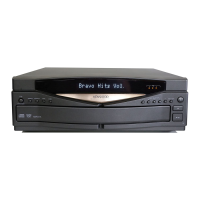
Do you have a question about the Kenwood D-R350 and is the answer not in the manual?
| Type | CD Player |
|---|---|
| Signal-to-Noise Ratio | 110 dB |
| Channels | 2 (Stereo) |
| Disc Format | CD |
| Output Level | 2.0 V |
| DAC | 1-bit |
| Digital outputs | Coaxial, Optical |
Instructions for safe operation before connecting power.
Warnings and precautions to prevent fire or electric shock.
Displaying text information from CDs like titles and artist names.
Use of advanced technologies for better sound quality and stability.
Functions for easily dubbing CD content onto tape.
Functions enabling systematic operation with other KENWOOD components.
Recommendations for proper ventilation and space around the unit.
Connecting the unit to amplifiers and digital components via audio or digital cables.
Connecting and operating components within the KENWOOD System "SERIES 21".
Overview of buttons, displays, and indicators on the main CD player unit.
Explanation of the standby mode and its power supply function.
Information about the standard remote control unit and its function.
Explanation of various function keys on the remote control unit.
Overview of GRC screens, icons, and joystick for navigation.
Details on how keys like ENTER and playback controls function on the GRC.
Initial GRC setup steps for model type and CD player configuration.
Further GRC setup steps involving Carrousel and Segment screens.
Detailed comparison of standard remote and GRC key functions.
Procedures for inserting and removing CDs from the player.
How to search for tracks using text information on CD-TEXT discs.
Step-by-step guide to play tracks sequentially from the beginning.
Instructions for pausing and stopping CD playback.
How to select and play a specific track number.
Procedures for skipping to the next or previous track.
How to search forward or backward within a track.
Explains the TRACK mode state where PGM, EDIT, and RANDOM displays are off.
Steps to initiate and perform title search on CD-TEXT discs.
Explanation of how long track titles are displayed using scrolling.
How to change displayed time information during playback.
Selecting different text information displays for CD-TEXT discs.
Automatically displaying all available text information for CD-TEXT discs.
Steps to select and program tracks in a desired order.
How to initiate playback of the programmed track sequence.
How to view and modify existing programmed track lists.
Procedure to append new tracks to an existing programmed sequence.
How to remove tracks from the programmed sequence.
Automatic creation of spaces between tracks for reliable tape recording.
How to set the unit to repeat only the programmed track sequence.
How to set the unit to repeat all tracks on the currently loaded disc.
Steps to disable the repeat playback function.
Procedures to select edit mode and enter the desired tape recording time.
How the CD contents are edited into files for tape sides.
How to verify the track numbers and remaining times after editing.
How to play back or record the edited CD content onto tape.
How to erase all edited data.
How to activate random playback for tracks on a disc.
How to select a different track while random playback is active.
How to stop random playback and return to normal playback.
Guidelines for handling, cleaning, and storing compact discs.
Warnings against using cracked, warped, or cleaning discs.
Types of discs that can be played by the unit.
Instructions for cleaning the exterior of the unit.
Warning against using certain CD accessories with this system.
Precautions and remedies for condensation issues.
Procedure to reset the unit's microcomputer to factory settings.
Table of common symptoms, causes, and remedies for unit malfunctions.
Technical details on system format, laser, and D/A conversion.
Technical details on frequency response, noise ratio, dynamic range, etc.
Power consumption, dimensions, and weight of the unit.
Regulatory warning regarding radio frequency energy and modifications.
